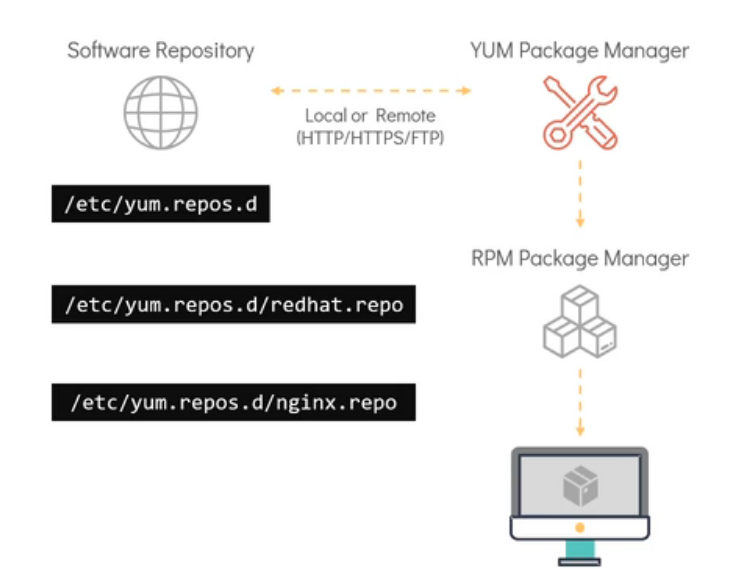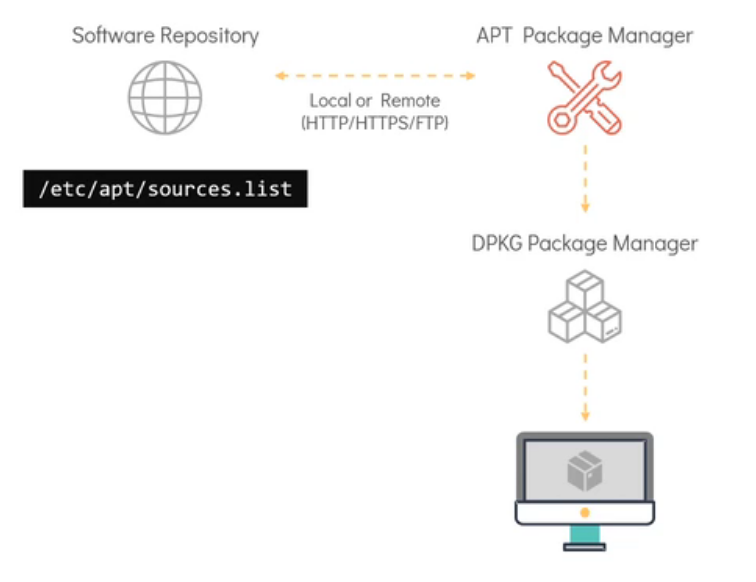03. Package Management
 Arindam Baidya
Arindam BaidyaTable of contents
- Q. What is the difference between CentOS, RHEL, and Ubuntu?
- Q. What is the difference between RHEL and CentOS operating system?
- Q. What is a Package?
- Function of Package manager
- Types of package managers
- RPM (Red Hat Package Manager)
- YUM (Yellowdog Updater Modified)
- DPKG (Debian Package Manager)
- Referencces

Q. What is the difference between CentOS, RHEL, and Ubuntu?
There are hundreds of Linux distributions in use today. One of the ways to categories Linux distribution is by the package manager it uses. For example, RHEL (Red Hat Enterprise Linux), CentOS. Fedora are based on RPM. Hence they are known as RPM based distribution. The Debian family including Ubuntu, Debian, Arch Linux, Linux Mint, etc. make use of Debian package manager such as dpkg
Q. What is the difference between RHEL and CentOS operating system?
CentOS is very similar to Red Hat Enterprise Linux. CentOS is a community driven enterprise operating system which is formed from Red Hat.
Red Hat on the other hand, is available only through a paid subscription. But with this subscription we can get support for mission-critical system, and quicker access to the latest features.
Q. What is a Package?
Package is a compressed archive that contains all the files which are required by our particular software to run.
- For example let consider we want to install an image editing software such as GIMP in Ubuntu system. Which stands for GNU Image Manipulation Program in this system. To do this, we can use of the gimp.deb package. This gimp.deb package contains all the software binaries and files needed for the image editor to run along with the metadeta which provides the information about the software itself.
Every distributions runs different sets of tools and libraries, software, and possibly even different linux kernels. As a result of this, the linux program may not run the same way from one system to another. To fix this, packages include a manifest of dependencies or list of program and versions that must be satisfied for the packaged software to run correctly on a given computer
A package manager is a software in a linux system that provide a consistent and automated process of installing, upgrading, configuring, and removing packages from the operating system.
Function of Package manager
Ensuring the integrity and authenticity of a package by verifying their digital certificates and checksums. To ensure that the package is downloaded from a trusted source and safe to install.
Simplifying the entire package management process, most packages provide powerful querying option, making it easier to lookup packages and then downloading, installing, or updating existing software from a software repository.
Grouping packages by function to reduce user confusion.
Managing dependencies to ensure a package is installed with all packages it requires.
Types of package managers
DPKG - base package manager for Debian-based distributions.
APT - a newer frontend for dpkg system, found in debain-based distribution such as Ubuntu, Linux Mint, Elementary OS.
APT-GET - traditional front-end for the dpkg system found in debian based distribution.
RPM - base package manager found in Red Hat based distributions such as Red Hat Enterprise Linux, CentOS, and Fedora.
YUM - a frontend for the RPM system found in Red Hat distribution.
DNF - more feature-rich front end for the RPM system.
RPM (Red Hat Package Manager)
Common distro that use RPM are Red Hat Enterprise Linux, CentOS, and Fedora.
File extension for package managed by RPM is .rpm.
RPM has five basic mode of operation
Installing →
rpm -ivh telnet.rpmhere, ‘-i’ stands for install, ‘-v’ stands for verbose which use to print the detailed output of the command.Uninstalling →
rpm -e telnet.comUpgrade →
rpm -Uvh telnet.comQuery → The RPM database stores information about all RPM packages install in the system in
/var/lib/rpmdirectory. It is used to query what packages are installed, what version each package is, and any changes to any files in the package since installation, along others. To query the database and get details about an installed package, userpm -q telnet.com. //rpm -qa | grep wget»rpmcommand to find out the exact package name forwgetinstalled on the system.//Verifying →
rpm -Vf <path to file>here, -V is for verify a package. Verifying a package compares information about files installed from the package with the same information from the original package. This is useful to make sure a package has been installed form a trusted and secure source.
Despites all this mode, it is important to note that RPM does not resolve package dependencies on its own. This is why we use a higher-level package manager called YUM.
YUM (Yellowdog Updater Modified)
Free and open-source package manager that works on RPM-based linux system.
YUM works with software repositories, which are essentially a collection of packages and provides package and dependency management on RPM based distros. The repository information is stores in the
/etc/yum.repos.dand the repository files have a .repo extension.YUM act as a high level package manager, but under the hood it still depends on RPM to manage packages on the Linux system.
YUM handles package dependencies very well. It is able to install any dependent packages to get the base package installed on the Linux system.

Here, redhat.repo repository comes bundled with the operating system. But we can add new repository in this directory in case we don’t want to use the official repo.
- The official repository sometime may not have the latest version of the software we want to install and sometime it may not have the software at all. In that case we create a new repo file and point it to a non-official or a third party repo and proceed with installation.
Sequence of steps involves while installing a package
yum install httpd → once a yum install command is issued, YUM first runs the transaction check. If the package is not installed in the system, YUM checks the configured repositories under the repos.d directory for the avalibility of the requested package. It also checks if any of the dependent packages are already installed in the system, or need to be upgrade. After this the transaction summary is displayed on the screen for the user to review. If we wish to proceed with install need to enter the Y button, this steps can be skipped by providing a -y flag with the yum install command. YUM will download and install the necessary RPMs to the Linux system.
yum repolist show all the repos added to the system.
yum provides scp to check which package should be installed for a specific command to work, need to use the yum provides command with the command name as the argument. In this example we are looking for the package that provides the SCP command using yum provide command.
yum remove httpd to remove a package.
yum update telnet to update a single package.
yum update to update all packages installed in the system.
DPKG (Debian Package Manager)
It is a low level package manager.
Package manager extension of DPKG is .deb
dpkg -i telnet.deb install or update an existing package
dpkg -r telnet.deb uninstall a package
dpkg -l telnet to list packages installed in the system along with version number in short description.
dpkg -s telnet to check the package status if it is installed in the system.
dpkg -p <path to file> details about packages such as version number, maintainer, etc.
Similar to RPM, DPKG does not honor the dependencies when it comes to package management. This is why we use higher level debian package managers such as apt, and apt-get.
apt and apt-get do not depend on each other.
apt (Advance Package Manager)
It is more user friendly and overall a better tool compared to apt-get.
apt acts as a front end package manager that relies on the dpkg utility.

Similar to yum, apt relies on a software repository that contains packages that would eventually be installed on the system. The software repository for apt is defined in the /etc/apt/sources.list file. The source can be a local one such as a directory on the file system or a CD-ROM, or can be a remote location that is accessed via HTTP, HTTPs, or FTP transfer protocols.
apt update to refresh the repository. This command is use to download package information from all available sources. A good time to run this would be immediately after installing the OS or after adding new sources.
apt upgrade used to install available upgrades of all packages currently installed on the system from the sources configured.
apt edit-sources also update the repositories. This opens up the /etc/apt/sources.list file in the text editor of your choice such as vim or nano.
Another way to add more repositories, update the sources.list file directly using a text editor such as the VI-editor. Once the repositories have been set up, you can make use of it to run apt commands.
apt install telnet to install a package.
apt remove telnet to remove a package.
apt search telnet can be used to look for a package in the repository.
apt list | grep telnet list all the available packages.
Referencces
Subscribe to my newsletter
Read articles from Arindam Baidya directly inside your inbox. Subscribe to the newsletter, and don't miss out.
Written by
Arindam Baidya
Arindam Baidya
🚀 Aspiring DevOps & Cloud Engineer | Passionate about Automation, CI/CD, Containers, and Cloud Infrastructure ☁️ I work with Docker, Kubernetes, Jenkins, Terraform, AWS (IAM & S3), Linux, Shell Scripting, and Git to build efficient, scalable, and secure systems. Currently contributing to DevOps-driven projects at Assurex e-Consultant while continuously expanding my skills through hands-on cloud and automation projects. Sharing my learning journey, projects, and tutorials on DevOps, AWS, and cloud technologies to help others grow in their tech careers. 💡 Let’s learn, build, and innovate together!